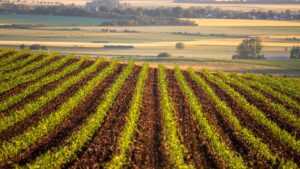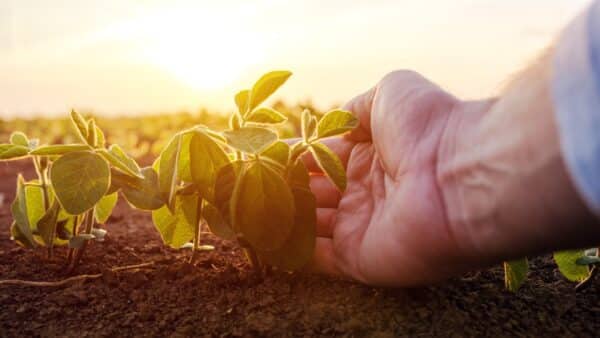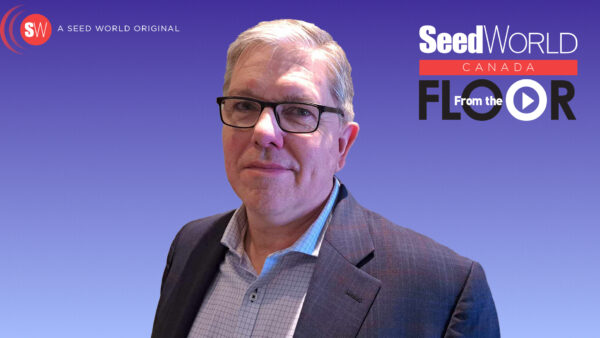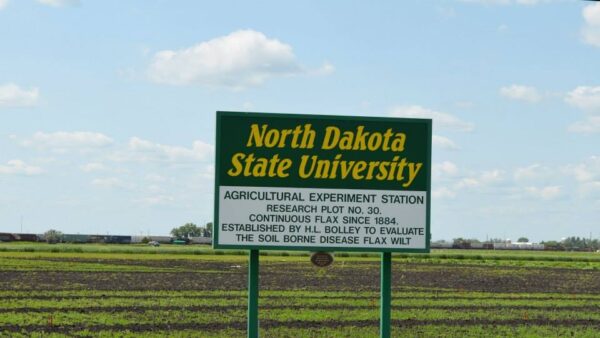“Diversity” is how many of something you have, and “genetic” references genes. These are the chemical compounds inside plants and animals that tell them how to grow and how to live, whether they should be coloured or not, tall or short, fast- or slow-growing, resistant to pests, able to grow under drought and many other characteristics. Genetic diversity is all about how many different genes there are in an organism and all the many possibilities those allow.
Let’s look at the genetic diversity of corn, for example, with Frank Kutka, North Dakota Sustainable Agriculture Research and Education (SARE) program coordinator.
Corn has a great deal of genetic diversity, says Kutka, who also serves as assistant director for North Dakota’s Dickinson Research Extension Center. There’s dent corn, or common field corn, which has a dimple at the top of the seed and is mostly yellow or reddish in color. Another corn population has genes for red and yellow, but not for the dent; these are very hard kernels, called flint corn. Some corn has genes for a dark red colour and tiny seeds, and a gene that helps them to pop when they get very hot. Corn also has genes that can make for huge kernels, like that found in cusco gigante. Some genes can make the kernel very soft and some genes make the kernel white. There are even genes when in the right combination make the kernel absolutely black.
“Corn has many thousands of genes and all of these different chemical signals can make for some incredible diversity,” Kutka says. “Not only can there be different varieties with their own traits, but some populations also carry many, many genes and have incredible genetic diversity — colours ranging from white and red to blue and black and from stripes to dots, and big to small. This genetic diversity explains why the world around us looks like it does.
“There are many, many different combinations of genes, which play out to form the many different kinds of plants and animals and things that we see around us every day.”
When plant breeders or farmers choose the seed to plant, they are also choosing which genes to pass on, Kutka shares. He says it’s this kind of selection that is the very basis for plant breeding.
“Farmers and plant breeders have been making these kinds of selections and improving the types of plants we grow for many thousands of years,” Kutka says.
Diversity Gives Depth
Unlike any other manufacturing industry, plant breeders, farmers and those in the seed industry cannot design a new variety from a white sheet of paper. Think about it, says Jean-Christophe Gouache, International Seed Federation (ISF) past-president: The design engineer at BMW or Toyota is not sitting down and working from an old blueprint. They are working from a clean slate to deliver innovative new vehicles to the market.
“Plant breeders do not have this luxury,” says Gouache, who started his career as a corn breeder. “You don’t design a new car with two existing older models staring you in the face, but plant breeders do design a new variety from at least two existing varieties or populations they mix. It’s from here that everything starts.”
Simply put: “Crop diversity is essential for life on earth.It underpins nearly everything we eat and drink,” according to the Crop Trust, which was founded in 2004 by the Food and Agriculture Organization of the United Nations and Bioversity International to help provide financial support for the preservation of crop genetic diversity through genebanks.
An extreme example of the consequences of the loss of genetic diversity is the Irish potato famine. Ireland relied so heavily on monoculture of potatoes that when blight caused the potatoes to rot, they lost their staple food source. It’s important to note that other social and economic factors were at play here, but the lack of genetic diversity was certainly a contributing factor.
Had the Irish deployed Frank Figge’s portfolio theory to its food economy, the infamous potato famine might not have dealt such a devastating blow.
The portfolio theory takes a lesson from the financial industry, where advisers recommend diversifying where and how you invest your money to help minimize risk and build assets. Crop diversity is your “portfolio.” This same concept, Figge argues, should be applied to preserving genetic diversity.
“Portfolio theory is usually applied to assets such as shares,” Figge wrote in his 2004 paper, “Bio-folio: applying portfolio theory to biodiversity.” “Genes, species or ecosystems can also be considered assets.”
An excerpt reads: “There is considerable research on the contribution of biodiversity to the resilience of ecosystems. Resilience of an ecosystem can be interpreted as the ability to absorb changes and disturbances before it changes from one state to another.”
Preserving and even creating genetic diversity is increasingly important as farmers and plant breeders look to deal with climate change and mounting pest and disease pressures.
“To have a chance to create new varieties that will perform, we need genetic diversity,” Gouache says. “The more sources of genetics that plant breeders have, the better their chance of mixing, combining and tackling the challenge they set out to address.”
“It is virtually impossible to exaggerate the importance of crop diversity,” said Erik Solheim, Norway’s former Minister of International Development in 2007 when the Bill and Melinda Gates Foundation made a $37.5 million grant to the Crop Trust and the government of Norway made a matching grant of $7.5 million.
These grants were earmarked to secure over 95 per cent of the endangered crop diversity held in developing country genebanks, many of which are under-funded and in disrepair. These dollars were also to be used to fund a comprehensive global information system that would allow plant breeders everywhere to search genebanks worldwide for traits needed to combat new diseases and cope with climate change.
While nearly everyone can agree on the importance of preserving genetic diversity, where we are today and how we do it can be highly controversial — fueled by passion, fear, dollars, politics and belief.
An estimated 20 per cent of plant diversity is under threat from habitat degradation, invasive species and over-exploitation, according to the Crop Trust.
A representative from the Bill and Melinda Gates Foundation once said: “There can be no food security without first securing the basis of our food production — the genetic diversity of every crop …”
All countries are interdependent on one another for vital plant genetic material.
To date, there have been a number of efforts to create frameworks to preserve genetic diversity. One is the Nagoya Protocol and the other is the International Treaty on Plant Genetic Resources for Food and Agriculture (ITPGRFA). In this article, we will focus on the latter. Formed under the auspices of the Food and Agriculture Organization of the United Nations, the treaty entered into force June 29, 2004, with the guidance of a governing body that is comprised of representatives from all contracting parties.
The Treaty’s Framework
The treaty sets out to accomplish three things. First, it aims to take care of the conservation of plant genetic resources for food and agriculture. Second, the genetic resources should be used in a sustainable manner. And third, access and benefit-sharing should be managed. The treaty also recognizes that farmers have contributed to the diversity of crops that feed the world; therefore, it works to ensure that recipients share the benefits they derive from the use of these genetic materials.
With 144 countries that are now party to the treaty, it has since established a global multilateral system (MLS) to provide farmers, plant breeders and scientists with access to plant genetic materials from 64 crops and to ensure that recipients share benefits they derive from the use of these genetic materials according to agreed procedures.
Those who access the materials must be from the treaty’s ratifying nations, and they must agree to use the materials totally for research, breeding and training for food and agriculture. The treaty prevents the recipients of genetic resources from claiming intellectual property rights over those resources in the form in which they received them, and ensures that access to genetic resources already protected by international property rights is consistent with international and national laws.
Additionally, those who access genetic materials through the MLS agree to share any benefits from their use through four benefit-sharing mechanisms established by the ITPGRFA.
While parties have access to more than four million vital plant genetic resources through the treaty and the treaty has positively impacted the lives of more than one million people, the benefit sharing framework has left the system broke.
Under the current system, benefit sharing can be monetary and non-monetary; however, non-monetary sharing is not always felt as sufficient, particularly by developing countries.
In principle, when accessing genetic resources from another country, the accessing party must abide by the Standard Material Transfer Agreement (SMTA), which has minimal upfront fees. Under the agreement, if the developed variety is not free for research and breeding, then the accessor is obligated to pay 1.1 per cent of gross sales, minus 30 per cent. If the variety is available for research and breeding, accessors are encouraged to voluntarily contribute an amount of their choice. There’s also an alternative form of benefit sharing for individuals or companies where they can pay .5 per cent of gross sales for a complete crop.
The challenge of benefit sharing has plagued the treaty since its inception. In 2013, an Ad Hoc Open-ended Working Group to Enhance the Functioning of the Multilateral System of Access and Benefitsharing was formed to develop a range of measures for consideration and decision by the Sixth Session of the Governing Body, which met in October 2015 in Rome, Italy.
The Governing Body of the Sixth Session reviewed the funding strategy, but essentially decided to let the Governing Body of the Seventh Session undertake a review of the funding strategy with “a view to enhance its functioning, and, in order to provide a basis for review, decides to reconvene the Ad Hoc Advisory Committee on the Funding Strategy in the 2016-17 biennium …”
No One-Size-Fits-All
It has been debated that a subscription system be the only mechanism to access plant genetic resources under the treaty. A subscription system for germplasm access was defined that would require payment into the system for a determined number of years. The annual subscriber’s fee would be calculated as a per cent of the subscribing seed company’s total global sales of crops under the treaty, minus 30 per cent. The subscriber would not pay on the quantity of germplasm access or on the sales of products derived from accessed germplasm.
A subscription-based model would provide certainty and predictability regarding financial income through the benefit sharing fund.
However, it is the position of ISF that only having a subscription-based system would not meet the needs or be beneficial to all participating parties. As such between the Sixth Session and the Seventh Session, ISF’s Gouache spent a significant amount of time working on this issue, and led the signing of a first-ever declaration of commitment from seed companies, stating that they would be willing to participate and at what level, committing real dollar figures.
Because of ISF’s contributions and interest in making the ITPGRFA work, Gouache was invited to speak as part of the opening ceremony for the Governing Body’s Seventh Session in Kigali, Rwanda. When Gouache showed up to the Seventh Session of the Governing Body in November of 2017, he had 41 signatories to the declaration.
As he stood before the Governing Body, he said: “I stand before you today as ISF president, and as the representative of a group of companies. We are ready to make a significant commitment to enhance the benefit sharing provisions of the MLS.
“The seed sector has always recognized the importance of plant genetic resources: the role they play in plant breeding, and the contribution they make to sustainable agriculture and food security. In fact, providing access to all plant breeders has always been a priority we share.
“Before us lies a great opportunity to work together to enhance the functioning of the MLS. We must build now a multi-access benefitsharing system that makes sound business sense, and meets several legal and economic conditions.
“These conditions need to be taken into account to build a SMTA that seed companies are willing to sign — one that respects their standard business practices. I‚Äôm talking about a system that serves the many, not the few.”
Despite his remarks and the declaration, no further decision was taken by the Governing Body to aid the benefit sharing portion of the treaty, and very little progress was made.
“If the Governing Body had approved a Standard Material Transfer Agreement with good business criteria and at an economic rate, those 41 companies would have been ready to serve,” Gouache says. “For many political reasons, it seems some delegates want to tackle new topics, instead of what’s already on the table.”
These talks will start again in another two years. “The solution to many of our challenges lies in the diversity of genetics,” Gouache says. “We need to get as many genetic resources into the hands of as many breeders around the world as we can. They need to be used and circulated. This is how we will be able to provide solutions to the challenges that are before us.”













